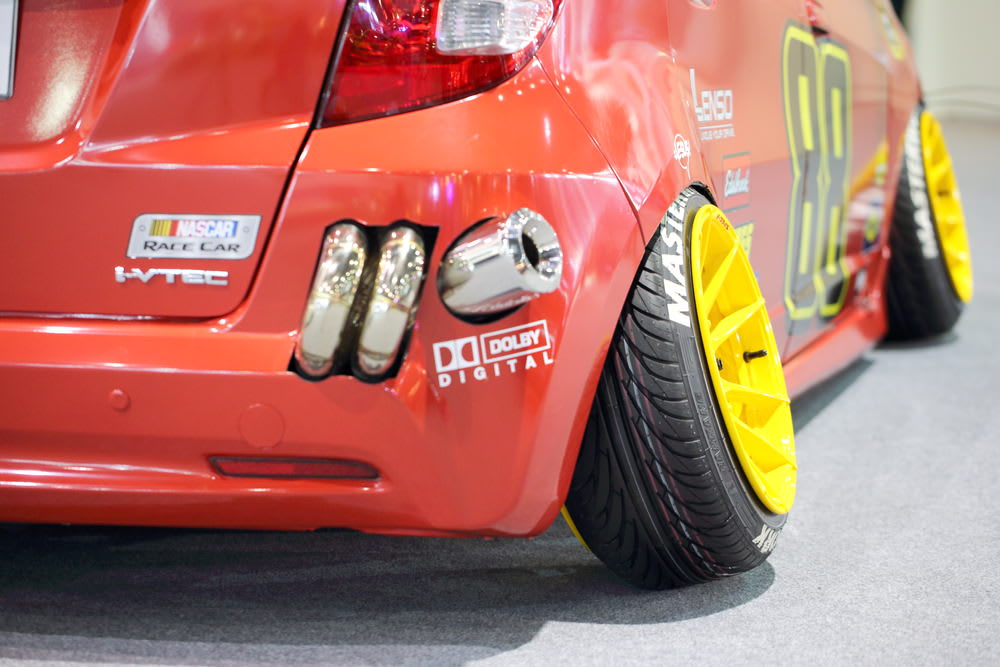

It’s increasingly common to see “tuner” cars (or less commonly, pickup trucks) with extreme camber settings — in other words, with wheels and tires that are noticeably tilted relative to vertical. Some owners may wonder whether changing their camber in this way is a good idea, or they may already know they’d like to do it but want to be sure it’s safe.
In order to decide whether changing a car’s camber is a good idea, it’s important first to understand what camber is and what it does. Camber is the term for the deviation from vertical of a car’s tires, when viewed from the front or rear. When the tops of the tires are closer to the center of the car than the bottoms, this is called negative camber; the opposite, when the tops are tipped outward, is called positive camber. The camber angle is measured in degrees, positive or negative, from vertical. Importantly, camber is measured while the vehicle is at rest, but the angle can change when it’s turning.
The first thing to understand about proper camber settings is that vertical — zero degrees camber — is almost always theoretically best if it can be achieved. When a tire is vertical its tread rests squarely on the road, meaning that the friction force available to accelerate, decelerate, and turn is as great as possible. Also, a tire that’s resting squarely on the pavement won’t wear as quickly as one that’s tilted, such that only the inner or the outer edge is bearing the load.
But if vertical is best, why do we need camber adjustments at all and why would we ever adjust to anything other than vertical? The answer is that when a car turns, the tires on the outside of the turn tend naturally to tip outward (positive camber), which can substantially reduce cornering ability by causing the tire to ride on its outside edge; building some inward tilt (negative camber) into the suspension when the vehicle is at rest can compensate for the outward tilt that occurs when turning. (The inner tire tips the other way and in theory positive camber would be helpful for it, but we can’t adjust for both and the outer tire tends to be more important.) The manufacturer’s camber settings represent a compromise between zero camber (vertical), which is best for straight-line acceleration and braking, and negative camber, which improves cornering performance.
What happens when camber is changed beyond the manufacturer’s recommended settings? Usually when people consider changing camber they’re contemplating adding more negative camber, or inward tilt. Within limits, adding negative camber can increase cornering power, at the cost of braking performance (and tire wear), and a very small change in this regard — a degree or less — can be fine. At greater angles, however, every aspect of performance suffers. Extreme negative camber (or positive, though this is less common) can help to achieve a certain appearance or to accommodate certain suspension modifications such as air bags, but vehicles with such modifications can be unsafe to drive because they simply won’t be able to brake well.
Race car mechanics choose the right camber for their cars’ races; often this will involve more negative camber than would be appropriate on a street vehicle, but other settings are possible. (For example, oval track racers, which turn in only one direction, are often set up with negative camber on one side and positive on the other.) Drivers of such dedicated racing vehicles know that there’s been a tradeoff in braking performance, and owners understand that tire wear will be increased.
But on a car that’s driven on the street, safety needs to be the primary concern and sacrificing a lot of braking ability for a minor advantage in cornering simply isn’t a good trade. Adjusting camber within or very near to the manufacturer’s recommended tolerances should be considered safe, but far outside that range (and here, even one degree is a big change), braking performance can fall off so quickly that it’s a poor idea. Some people like the look and others think the cornering advantage may be worth it, but in any car that’s going to be driven on the street, extreme camber just isn’t safe.
One more thing to note about cars that have been lowered a great deal: Sometimes such cars have extreme negative camber not because the owner intended it, but because the lowering process changed the camber. It’s important to remember that any change to the suspension can affect safety; in the case of lowering that produces excessive camber, the lowering itself may not be dangerous but the resulting camber may be.



